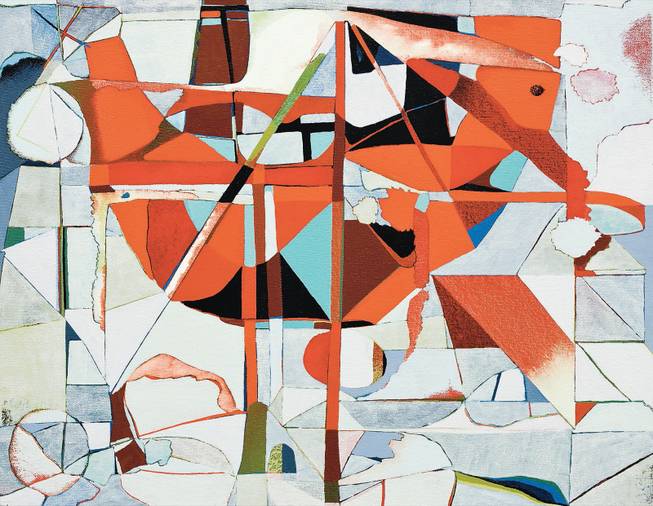
Brad Eberhard painting/Trojan Cardinal, 2008/Collection Susan Bay Nimoy and Leonard Nimoy/Courtesy the Artist and Thomas Solomon Gallery, Los Angeles, Calif.
Monday, Dec. 1, 2008 | 11:18 a.m.
More info
- What: "L.A. Now," emerging Los Angeles artists
- When: Dec. 12 to March 8; lecture with curator David Pagel at 5:30 p.m. Dec. 11.
- Where: Las Vegas Art Museum, 9600 West Sahara Ave.
- Cost: General admission is $6 for adults, $5 for seniors and $3 for students.
- Contact: 360-8000 or visit www.lvam.org.
When curator and L.A. art critic David Pagel talks about the regional art scene, he is sure to stress what it doesn't have to be: elitist.
At his Dec. 11 Las Vegas Art Museum lecture, he wants to present "straight talk about stuff that usually gets tarted up in pretentiousness."
This is the art: a grad student who artificially pollinates palm trees; gooey images of martyrdom sourced from 14th century paintings; art that mixes video-gaming culture with Polynesian anthropology.
And all of it is accessible to anyone who is interested, he said.
Pagel is the curator of "L.A. Now," showing Dec. 12 to March 8 at the 9600 West Sahara Ave. museum, a mad mixture of all this and more. A show so wide ranging he doesn't believe anyone will like everything, "but if you don't like anything you're probably not alive." Pagel's lecture begins at 5:30 p.m. in the museum's education center.
Wendell Gladstone is one of 20 L.A. artists featured in the show. Pagel described his piece as a squeaky-clean painting that tells a cycle-of-life story. Often Gladstone's work invokes futuristic video-gaming culture and Pacific Northwest symbolism.
"L.A. Now" is not a theme show, so visitors shouldn't expect the collection to make cohesive sense, Pagel said. He picked pieces that stuck in his mind this year.
"The grouping isn't based on a clear idea — it's based on no idea at all," Pagel said.
And there's no one better to curate a show on L.A.'s emerging artists, said museum Director Libby Lumpkin. Pagel frequents L.A. galleries as an art critic for the Los Angeles Times. He's also a Claremont Graduate University associate professor of art theory.
L.A. is a necessary trip for local art lovers, but Lumpkin knows there are plenty of people who can't get there that often. Since the '60s, the area has produced artists who become part of the contemporary art canon, she said. Though competition arises from New York and London, L.A. continues to have a vibrant scene with its museums, galleries and top art schools. Pagel chairs one of them, she said.
"We are a suburb to L.A. in terms of the arts community," Lumpkin said. "Vegas is just getting started. So we rely on L.A."
And L.A. fosters artists like Nathaniel de Large, who will show a series of 50 photographs that document a year-long guerilla art endeavor. It started with him artificially pollinating a long row of palm trees on Foothill Boulevard in Upland, Calif. It ended with de Large erecting a two-foot tall bronze statue of himself on the boulevard.
As de Large's former professor, Pagel had the inside scoop on the artist's endeavor. De Large waited for the dates to grow. He harvested them and made them into date jerky. He sold the jerky to pay for bronze to make a sculpture of himself in the palm yoga position, legs straight, palms above his head, "which isn't very big because bronze is more expensive than dates."
The statue won't be at the Las Vegas exhibit, because it's mounted into the Foothill Boulevard sidewalk. De Large did this all without permission.
"He harvested a secret crop and mounted his statue on the sidewalk," Pagel said. "It's so sweet and visible and forlorn on this corner near all these chain stores."
While de Large remained close to the source of his art, in a sense even consuming it, Jeni Spota remains far in time from her inspiration. Her four small oil-on-canvas paintings look like cake frosting, Pagel said.
"But when you look closely, they are horrific scenes of martyrdom, crucifixion, people being boiled alive," he said.
Spota looked to a 1960s movie, which was inspired by a collection of novellas called "The Decameron," penned by Italian author Giovanni Boccaccio, based on 14th century Giotto paintings, Pagel said.
It's a confusing lineage, the curator said, but all the museum visitor needs to know is that Spota, Boccaccio and Giotto portrayed the troubled relationship between God and man.
Becky Bosshart can be reached at 990-7748 or [email protected].

Join the Discussion:
Check this out for a full explanation of our conversion to the LiveFyre commenting system and instructions on how to sign up for an account.
Full comments policy